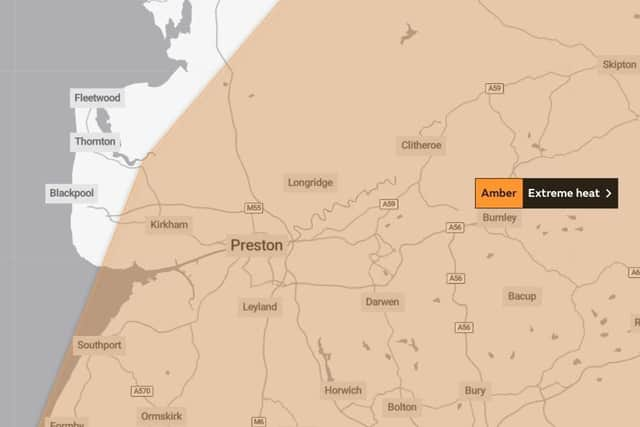Amber weather warning for extreme heat in Lancashire: Here’s everything you need to know including what it means, how hot it will get and what parts of the county will be affected as Met Office extends warning
and live on Freeview channel 276
When is the warning for extreme heat in place?
The amber warning for extreme heat issued by the Met Office was initially in place from midnight on Sunday (July 17) through to Monday (July 18), however, on Wednesday (July 13) the Met Office extended the warning into Tuesday, July 19.
What is an extreme heat warning?
The Met Office has a number of weather warnings it uses to alert the public to potentially hazardous conditions, such as for rain, snow, wind and ice. Extreme heat has now joined these warnings.
Advertisement
Hide AdAdvertisement
Hide AdThe alerts can come in three levels: yellow, amber, and red, depending on severity.
Dr Will Lang, Head of Civil Contingencies at the Met Office, said of the extreme heat warning: “We know that the impacts of climate change are resulting in an increase in the frequency and severity of extreme heat events.
“The extreme heat warning joins our other warnings to ensure that no matter what the weather conditions, we at the Met Office have a method of communicating these impacts to the public in as efficient a way as possible.”


The warning is based on the impact of weather conditions, rather than being assigned to any particular temperature.
Advertisement
Hide AdAdvertisement
Hide AdThe Met Office explains: “This means that different conditions in different areas of the country may trigger an extreme heat warning, and the threshold for an extreme heat warning in Aberdeen, for example, is likely to be lower than one covering London.”
Will all parts of Lancashire be affected?
While the amber warning covers the majority of the county, Lancaster, Blackpool and parts of Fylde and Wyre are not expected to be as badly affected. However caution should still be taken.
How hot will it get on Sunday and Monday?
Temperatures could reach highs of 31C on Sunday and Monday in areas affected by the amber warning, including; Preston, Kirkham, Burnley, Blackburn and Southport. Other areas just outside of the extreme heat warning, including; Blackpool and Lancaster, are likely to hit 27C.
Temperatures are forecast to be at their highest between 1pm and 7pm each day.
This is what the Met Office has said:
Advertisement
Hide AdAdvertisement
Hide AdWeather experts at the Met Office are predicting that the extreme temperatures could result in population-wide adverse health effects particularly for the most vulnerable.
Necessary changes to working practices and daily routines may be necessary, due to travel disruption including, road closures, delays and cancellations to rail and air travel services.
A Met Office spokesman said: “Temperatures will rise again later this week and over the coming weekend, likely peaking on Sunday and Monday, but may last into Tuesday in places.
"Some exceptionally high temperatures are possible and cumulative effects of warm nights and hot days are expected to bring widespread impacts to people and infrastructure.”
What are the best ways of keeping cool and avoiding heat exhaustion?
Advertisement
Hide AdAdvertisement
Hide AdMotorists are being urged to use eight top tips to keep cool in the car this summer. Although most new cars come with a sufficient climate control system, many drivers are still having to put up with sweltering conditions while they’re out on the road.
Top tips to stay cool while driving include, staying hydrated, hanging a wet rag over the vent, using frozen water bottles as ice packs and obtaining a mini-fan.
You can read more top tips here.
The UKHSA is also urging people to take care in the heat and be aware of the common signs of heat exhaustion and heatstroke.
Heat exhaustion is not usually serious if you can cool down within 30 minutes, but if it turns into heatstroke, it needs to be treated as an emergency, the NHS says.
What are the symptoms of heat exhaustion
Key warning symptoms of heat exhaustion include:
- headache, dizziness and confusion
- loss of appetite and feeling sick
- excessive sweating and pale, clammy skin
- cramps in the arms, legs and stomach
- fast breathing or pulse
- a high temperature of 38C or above
- being very thirsty
You can read more about the symptoms and what to do here.